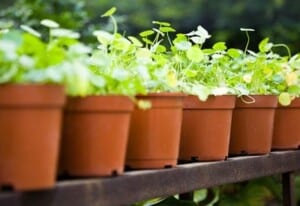While houseplants can add a touch of greenery to your home, some can also pose a serious threat to your furry friends.
Studies have shown that household plants are one of the most common items that endanger pets at home, so it’s essential to recognize and avoid toxic plants to ensure the safety and well-being of your pets.
Let’s dive in and learn about the top 10 poisonous plants that every pet owner should know about:
Philodendrons

With heart-shaped leaves and long slender vines, it’s easy to guess why philodendrons are popular houseplants.
However, remember that this plant contains insoluble calcium oxalates, which can irritate your pet’s lips, mouth, and tracts of their gastrointestinal system.
The ingestion of philodendron plants can cause:
- Irritation
- Mouth pawning
- Drooling
- Retching
Sago Palm

Sago palms are tiny palm-like trees with stiff fronds that can live indoors or outdoors. This small plant is toxic to all pets, and while leaves and bark can harm your four-legged friend, its “seeds” or “nuts” contain the biggest amount of toxins. Symptoms caused by Sago Palm ingestion include:
- Vomit
- Diarrhea
- Seizures
- Liver failure
Amaryllis Belladonna

Amaryllis flowers contain lycorine, a compound mainly concentrated in the plant’s bulb.
If your pet nibbles on any part of this flower, it can manifest nasty symptoms of Amaryllis toxicity, which includes GI issues, tremors, and lethargy.
Besides these common symptoms, the ingestion of Amaryllis Belladonna can also cause:
- Nausea
- Vomiting
- Diahrrea
- Drooling
- Low blood pressure
- Respiratory distress
Daffodils

This popular bloom can brighten up any garden or home with its beautiful flowers. However, if you plan on getting one, keep it out of your pet’s reach since every part of this flower is toxic. Even the water it sits in can be dangerous if consumed. Symptoms can depend on different factors, including which part of the plant was ingested, the amount eaten, and your four-legged friend’s overall health.
The most common signs of Daffodil ingestion include:
- Vomiting
- Diarrhea
- Salivation
- Low blood pressure
- Seizures
- Tremors
- Cardiac arrhythmia
- GI tract irritation
- Drooling
- Difficulty breathing
Oleander

Commonly used as a landscape plant (especially on the West Coast), oleander is a bushy shrub growing as high as 12 feet.
It’s mainly prized for its cluster of flowers.
Every part of this plant is poisonous for pets, from the roots to the petals. The ingestion of oleander can cause additional symptoms such as:
- Abdominal pain
- Diarrhea
- Excessive salivation/drooling
- Heart rate and heart rhythm changes
- Possible death
Cyclamen

Cyclamen has intensely colored blooms, making it a popular houseplant, especially during spring.
Although this plant is mainly recognized for its beauty, its ingestion is highly toxic. Ingesting this flower mainly causes gastrointestinal symptoms. If its roots get eaten, it can affect your furry friend’s heart rate and even death.
The main symptoms cyclamen ingestion causes are:
- Drooling
- Vomiting
- Diarrhea
Hemlock

Hemlock is one of the most poisonous plants on this list, as even the tiniest nibble of this toxic plant can endanger your pets in a matter of hours.
Hemlock poisoning can occur by ingesting the plant directly or the water it is in. Water hemlock poisoning symptoms include:
- Excessive drooling
- Increased temperature
- Nervousness
- Dilated pupils
- Increased heart rate
- Panting
- Twitching
- Seizures
- Comma
- Ataxia
- Seizures
- Weakness
- Difficulty breathing
- Weekend pulse
- Blood in stool
- Sudden death
Azalea

All parts of this flower contain a highly toxic natural compound called grayanotoxin. While an upset stomach is the most common sign of this flower, this compound’s reaction depends on how much was consumed. Due to its smell, pets rarely eat a lot of this flower, but when it happens, some symptoms include:
- Extreme weakness
- Tremors
- Irregular heart rate
- Slowed heart rhythm
- Low blood pressure
Tulips

Tulips are among the most popular flowers many love to display indoors and outdoors. However, pet parents should use these spring-blooming flowers cautiously, as they can poison their four-legged friends.
If your pet chews on this flower’s brightly colored petals, they’ll probably get an upset stomach.
Nevertheless, the real danger lies when your four-legged friend digs and eats up the newly planted bulbs containing the highest concentration of toxins.
Tulip bulb ingestion can cause:
- Upset stomach
- Loss of appetite
- Depression
- Weakness
Lily of the Valley

Besides being sweet smelling, having adorable white bell-like shaped flowers, and their ability to thrive almost anywhere, there are several reasons why the lily of the valley is such a popular garden plant.
But one thing this flower’s beauty masks is how toxic and poisonous it is to pets. Pets’ exposure to Lily of the Valley (and most lilies, for that matter) can lead to these symptoms:
- Dizziness
- Diarrhea
- Vomiting
- Disorientation
- Low blood pressure
- Seizures
- Arrhythmia/irregular heartbeat
- Coma
Top 10 Most Hilarious and Romantic Courtship Rituals in the Animal Kingdom

Nature is full of surprises, and when it comes to mating rituals, some animals take it to a whole new level. From elaborate dances to strange vocalizations, some creatures have developed unique, romantic, and hilarious ways to attract a mate.
12 of the Cutest Animals in the World, According to the Internet

From fluffy foxes to playful meerkats, there are plenty of animals that will make you go, “Aww.” Here is a list of some of the cutest wild animals in the world, according to the internet.
13 Dogs That Could Actually Be Smarter Than You

There’s a good reason why dogs are frequently considered man’s best friend. They are dependable, loving, and constantly present for you.
However, did you know that some canine breeds also possess extraordinary intelligence? Let’s look at 12 dog breeds with incredibly high IQs.
10 Simple Ways to Attract Bees to Your Garden (and Help Save the Planet)

Creating a bee-friendly garden is not only beneficial for our buzzy friends, but it’s also great for our environment.
You can create a welcoming environment for bees and other pollinators by making a few simple changes to your garden.
These 15 Cat Breeds Surprisingly Act More Like Dogs Than Cats

Cats are often praised for their independence and aloofness, but did you know that some cat breeds can be more dog-like in their behavior? These breeds are known for being loyal, playful, and even trainable.
This originally appeared on Planet Natural.











